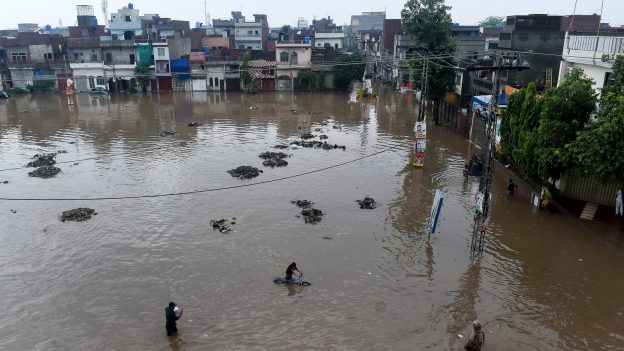Unprecedented monsoon rains and flooding continue to affect the people and have affected over 30 million people over the last few weeks. Though the figures vary from 30 million to 33 million, the updates pouring in from Sindh and Balochistan and parts of Southern Punjab suggest that the number of affectees will rise and is likely to depict a scene more alarming than the 2005 earthquake in Pakistan.
Chief Minister Sindh Syed Murad Ali Shah said the number of affected in the province has surpassed 10 million. He has issued a call to the affluent classes to play their part in relief operations across the province as the provincial government cannot meet the challenge alone.
Over 23 districts of the province have been declared calamity-hit areas where the damages are being assessed. As per media and social media reports, the loss on accounts of infrastructure is huge.
In his emergent televised message, Sindh Chief Minister Syed Murad Ali Shah said, “I have visited almost all the districts of the province and found everything inundated with rain water,” he said and added that the people who have been temporarily settled at relief camps are in a state of shock after losing their near and dear ones, their cattle, and other belongings.
The CM said women and children are living with tears in their eyes in relief camps.
Shah said that the riverine floods of 2010 had submerged all the cities, towns, and villages on the right bank of River Indus while the flash flood of 2011 had flooded the entire left bank and in those days our road network was not so good and despite this, philanthropists had helped the homeless and displaced people.
The chief minister said: “Compared to 2010 and 2011 our road network, including link roads and farms to market roads provides easy access, therefore philanthropists, welfare organizations and donor agencies should visit to take stock of the situation and help and support the distressed people.
Balochistan another affected province of Pakistan seems to be the hardest hit where not only the number of displacements is high but also the economy of the province has washed out with the floods. Over 5 lakh animals including cattle, one of the important sources of livelihood for the local people have died.
Thousands of kilometers of roads and many bridges have been washed out and other infrastructures have been damaged badly.
The torrential rains that triggered massive floods last month have also killed over 900 people all over Pakistan.
Some reports say Sindh in the country’s southeast and Balochistan in the southwest are the two most affected provinces. More than 504,000 livestock have been killed, nearly all of them in Balochistan, while damage to nearly 3,000 km of roads and 129 bridges have impeded movement around flood-affected areas.
Rehman and his cabinet colleagues say Sindh is the hardest hit province in the last few days. Sindh has requested 1 million tents for the affected people.
Reports from locals say there is a scant number of dry patches of land in many districts and those also are threatened by flooding in the canal system of the Indus River. The flood protection dykes along with the Indus are also facing the onslaught of the flood water on the right side of the river.
“South of Pakistan is inundated almost underwater. … People are going to higher ground,” Rehman said. “Needs assessment is being done, we have to make U.N.’s international flash appeal; this is not the task of one country or one province, it is a climate-induced disaster,” she added.
Rehman said Sindh has received “784%” more rainfall this month than the August average, while the province of Balochistan had received nearly 500% more.
Federal Minister for Planning and Development Ahsan Iqbal also said that 30 million people had been affected, a figure that would represent about 15% of Pakistan.
However, the U.N. agency Office for the Coordination of Humanitarian Affairs (OCHA) said that the monsoon rains had affected some 3 million people in Pakistan of which 184,000 have been displaced to relief camps across the country.
The National Disaster Management Authority (NDMA) said that 150 kilometers of roads had been damaged across the country and over 82,000 homes have been partially or fully damaged.
Since mid-June, when the monsoon began, over 3,000 kilometers of road, 130 bridges, and 495,000 homes have been damaged, according to NDMA’s situation report in the last week of August, figures also echoed in the OHCA report.
Funding and reconstruction efforts will be a challenge for cash-strapped Pakistan, which is having to cut spending to ensure that the International Monetary Fund approves the release of much-needed bailout money. ERMD
Monsoon rains, floods pose colossal challenge
on 09/01/2023








